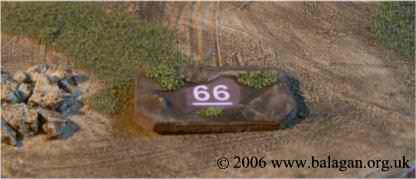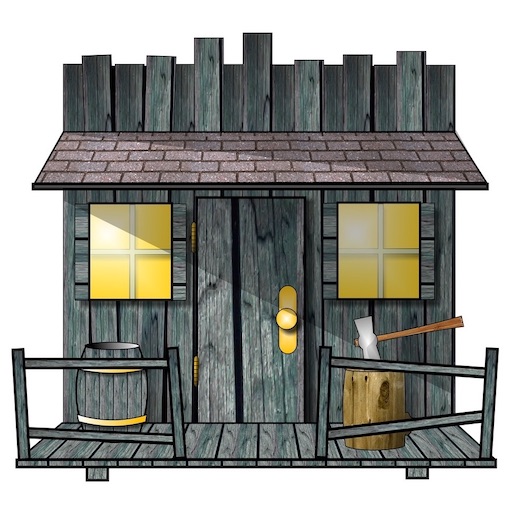Some musing on hidden deployment in Crossfire. Standard The Fog of War is hard to represent on a wargaming table – the only attempt Crossfire makes in this area is to allow the defender to use Hidden Placement. A Crossfire table has masses of terrain features and depending on the scenario the defender has the option of hidden deployment within those features. Crossfire proposes a particular method for hidden deployment – Numbered Terrain Markers – but some people use Maps or Hidden Placement Cards, and the method I use most often is Hidden Unit Markers.
Details of each of these methods are below, but here is a summary:
| Method | Markers are conspicuous on table | Possible to forget where troops are | Possible to place troops in non-existent feature | Possible to cheat | Provides visual record of RBF | Extra effort required |
|---|---|---|---|---|---|---|
| Maps | No | Difficult | Yes, feature might not be on table | Yes | No | Draw map |
| Numbered Terrain Markers | Yes | Possible | Yes, number might not be on table | Yes | Yes | Make the counters |
|
Moderate | Possible | Yes, number might not be on table | Yes | Yes | Make the counters |
|
Hardly at all | Possible | Yes, number might not be on table | Yes | Yes | Make the counters |
|
Moderate | Possible | Yes, number might not be on table | Yes | Yes | Make the counters |
| Hidden Placement Cards | Yes | No | No | No | Yes | Make the counters |
| Hidden Unit Markers | No | Very likely | No | No | No | Make the counters |
Regardless of the method of indicating hidden troops, All Hidden stands in a a particular feature are revealed when:
- Any one of the Hidden Squads Move or Fire.
- An enemy stand enters the terrain feature.
- The enemy succeeds with Recon by Fire on the terrain feature.
Revealed troops can be located any where in the terrain feature.

Example Map
Maps
Writing hidden deployment on a map is pretty obvious. Depends on whether you want to draw a map or not, and, as Crossfire uses a lot of terrain, maps can be quite complex.
Numbered Terrain Markers

Numbered Terrain
Markers
This is the official Crossfire method for recording hidden squads (section 5.3a, p. 8). Basically you put a numbered marker visibly on every feature in which a side is allowed to deploy. Some markers will be dummy markers, and not correspond to any real troops, but the others will correspond to a list of stands that are hidden in the feature. I have made up some Numbered Terrain Markers (PDF) that can be glued to cardboard and cut out.
The plain counters interfere with the aesthetics of the game, however, there are ways to enhance the visual appeal:

Terrain
Marker
with flock
A touch of flock
I took my basic Numbered Terrain Markers (PDF) and applied some scenic effects – plaster, paint and dots of flock (see Flocking for details). This greatly improved the aesthetics and made them less conspicuous on the table.
Piles of Rocks
My mate Paul Ward has made up little piles of stones on a small disk. The number is underneath the disk. This has the advantage that the table is free of offensive looking markers, but on the other hand you have to pick up the pile of rocks to know what the number is.
Individually based figures
Chuck Parrot paints single painted figures on 1.25″ stands and creates a mini diorama with the figure partially concealed in bits of terrain. Add a nice visible letter in the corner and voila! hidden markers that blend in well with the game and distinct enough from his other forces to spot easily.
Similarly Miniaturezone suggests painting unused figures grey and using them on the numbered markers. Miniaturezone has good examples – look under Articles then “Wargame & Modelling Related Techniques and Information” then “Wargames for Dummies (or Dummies for Wargames)”.
My own version look like this:

Individual Based Figures
These can also be used for ghosts i.e. hidden movement markers.

Hidden Placement Card
Hidden Placement Cards
I haven’t used this method, but I have seen it used. Quite simple yet clever, and there is no chance you’ll forget where your troops are.
Hidden placement cards provide a mechanism for both marking where troops are actually located, and for indicating which features have been reconnoitered by the enemy.
Use a flag on a 7.5 cm by 5 cm card for this purpose; the front has the national flag of the unit (or some such) and the back of the card is blank to allow the owner to write on it. Each terrain piece gets a card during the deployment phase. The owning player writes on the back what troops are hidden in the feature (usually none).
If the card is blank on the back when revealed, then it is removed. If the card represents real troops then the card is replaced by the troops.
I’ve made up sheets of hidden deployment cards for my interests in WWII. (I seem to recall I got the original flags for these sheets from the flags of the world site.) There are 16 flags per sheet.
German
Soviet
Spanish i.e. Blue Division – I’ve used the flag from 1945.
Flags based on those from:
http://www.crwflags.com/fotw/flags/es-1938.html
http://www.crwflags.com/fotw/flags/de}nsdap.html
http://www.crwflags.com/fotw/flags/su.html
Hidden Unit Markers
This is the method used at the Shed. All stands have a Hidden Unit Marker indicating the, nationality, stand type and ID. The coloured band at the top of each marker indicates the nationality – in this case Soviet.

Hidden Unit Markers
The examples are all from 1st Company:
- 1-2 Rifle meaning Rifle squad of 2nd Platoon, 1st Company
- 1-2 Rifle IAT is also a Rifle squad of 2nd Platoon, 1st Company, but one that has an Infantry Anti-Tank Weapon (most likely an Anti-Tank Rifle).
- 1 HMG meaning a HMG from the 1st Company.
- 1 Comm meaning the Commissar attached to 1st Company.
These counters are placed underneath the terrain features to indicate that stand is hidden there.
I’ve made up Hidden Unit Markers for Germans and Soviets (PDF). Just print them out, glue them to cardboard, and cut out.
(This approach also represents a very low cost option in getting started with Crossfire – just use the markers for the rest of the game as well, i.e. you don’t need figures.)
